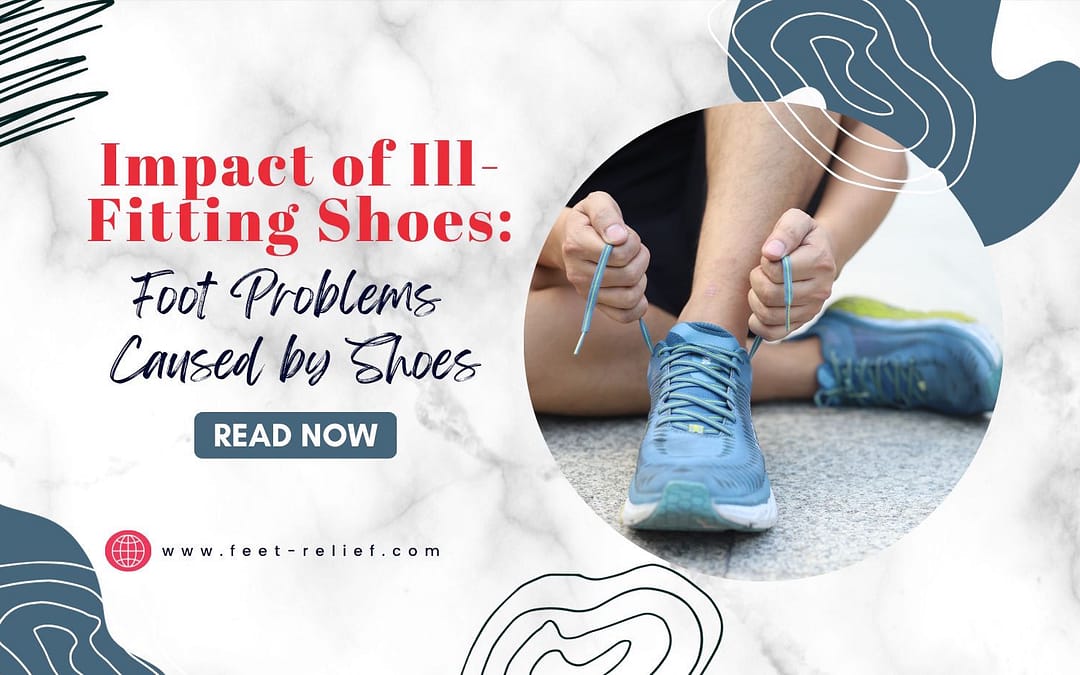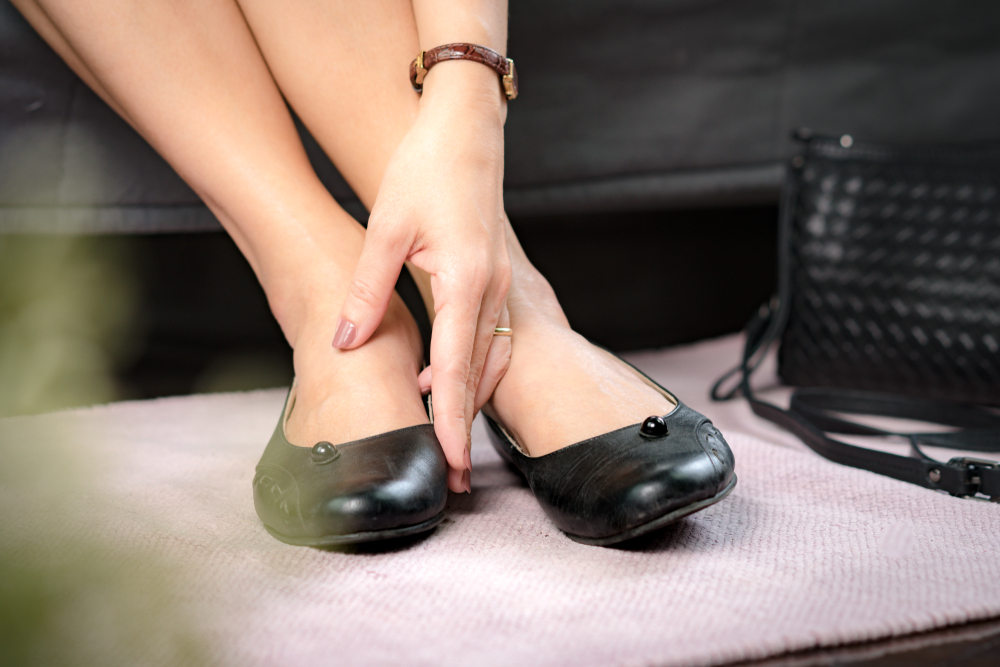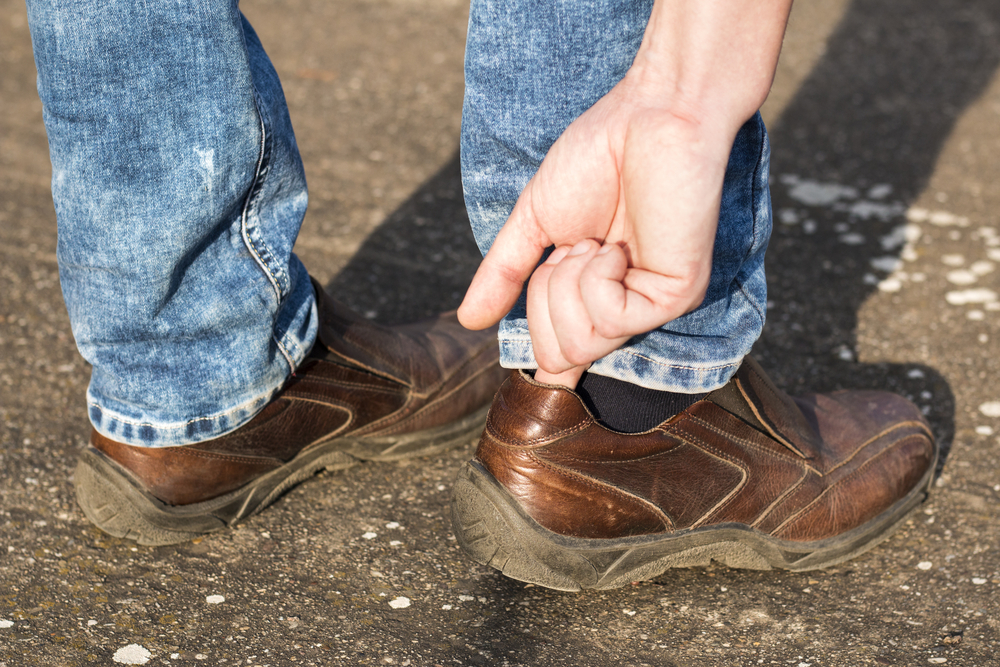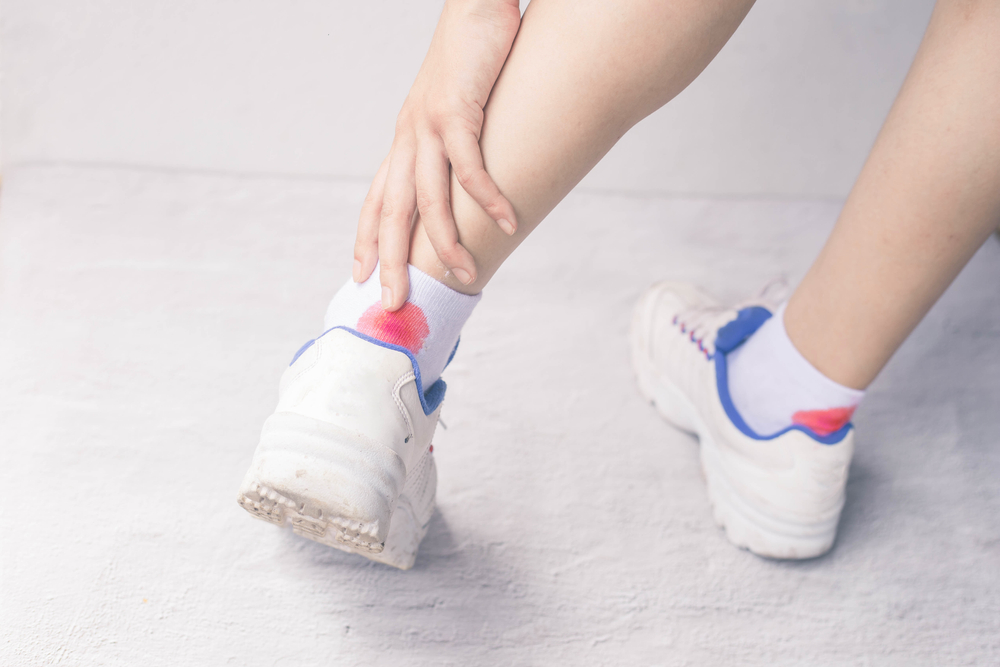Feet-Relief is supported by our audience. When you purchase through one of our links, we may earn a small affiliate commission. As an Amazon Associate I earn from qualifying purchases.Your cost is not affected.
Foot Problems Caused By Shoes: The Impact of Ill-Fitting Shoes on Foot Health
Foot pain affects your entire life. And many foot problems are caused by ill-fitting shoes. Most people shop for shoes based on color or style. But to avoid foot problems caused by shoes, read on to understand the full impact of ill-fitting shoes on foot health.
Foot pain can be a debilitating condition that affects our daily lives. One common cause of foot pain is ill-fitting shoes. Wearing shoes that do not provide proper support or fit correctly can lead to a variety of foot problems and discomfort. In this comprehensive guide, we will explore the impact of ill-fitting shoes on foot health, including the most common foot problems caused by wearing the wrong shoes. We will also provide tips and recommendations for finding the right shoes and maintaining optimal foot health.
The Complexities of the Foot
Before delving into the specific foot problems caused by ill-fitting shoes, it is important to understand the complexity of the foot. The foot is a remarkable structure consisting of bones, muscles, ligaments, and tendons that work together to support our body weight and facilitate movement. Each foot has 26 bones, 33 joints, and over 100 muscles, tendons, and ligaments. This intricate system allows us to walk, run, and perform various activities.
Proper foot alignment and function are crucial for maintaining overall foot health. When we wear shoes that do not accommodate our foot’s natural structure and movement, it can lead to imbalances, strain, and pain. Ill-fitting shoes can also exacerbate underlying foot conditions and increase the risk of developing new problems.
The Top 5 Worst Types of Shoes for Foot Pain
Not all shoes are created equal when it comes to foot health. Some types of shoes are more likely to cause discomfort and foot problems than others. Let’s explore the top 5 worst types of shoes for foot pain and the effects of wearing tight shoes:
1. High Heels
High heels may be fashionable, but they can wreak havoc on our feet. Wearing high heels shifts our body weight forward, placing excessive pressure on the balls of the feet. This can lead to conditions such as metatarsalgia, bunions, and hammertoes. High heels also alter the natural alignment of the feet and can contribute to issues with balance and stability.
2. Pointy-toed Shoes
Pointy-toed shoes may be stylish, but they often sacrifice comfort and foot health. Shoes with narrow toe boxes squeeze the toes together, leading to deformities like bunions and corns. These shoes also restrict the natural movement of the toes, which can cause discomfort and hinder proper foot mechanics.
3. Flip-Flops
Flip-flops are a popular choice for warm weather, but they provide minimal support and protection for the feet. The lack of arch support and cushioning in flip-flops can lead to arch and heel pain, as well as plantar fasciitis. Additionally, the constant gripping of the toes to keep flip-flops on can strain the foot muscles and contribute to fatigue.
4. Ill-fitting Athletic Shoes
Athletic shoes are designed to provide support and cushioning during physical activities. However, wearing ill-fitting athletic shoes can lead to a host of foot problems. Shoes that are too tight cause blisters, calluses, and ingrown toenails. On the other hand, shoes that are too loose may not provide adequate stability, often resulting in ankle sprains and other injuries.
5. Flat Shoes without Arch Support
Flat shoes may seem like a comfortable choice, but they often lack proper arch support. When the arches of the feet are not properly supported, it can lead to conditions such as plantar fasciitis, flat feet, and overpronation. It is important to choose flat shoes that offer arch support and cushioning to maintain optimal foot health.
The Consequences of Ill-Fitting Shoes
Wearing ill-fitting shoes can have serious consequences for foot health. Here are some of the common foot problems that can arise from wearing the wrong shoes:
1. Bunions
Bunions are bony bumps that form at the base of the big toe. They develop when the big toe joint becomes misaligned, causing the joint to protrude outward. Ill-fitting shoes, especially those with narrow toe boxes, can worsen bunions by putting pressure on the affected joint. This can lead to pain, swelling, and difficulty walking.
2. Corns and Calluses
Corns and calluses are thickened areas of skin that develop in response to friction and pressure. Ill-fitting shoes can create constant rubbing and friction on certain areas of the feet, leading to the formation of corns and calluses. These can be painful and may require professional treatment to alleviate discomfort.
3. Ingrown Toenails
Ill-fitting shoes that are too tight or narrow can cause the toenails to grow into the surrounding skin, leading to ingrown toenails. Ingrown toenails can be painful and may become infected if left untreated. Properly fitting shoes with enough room for the toes can help prevent this condition.
4. Plantar Fasciitis
Plantar fasciitis is a common foot condition characterized by inflammation and pain in the plantar fascia, a thick band of tissue that runs along the bottom of the foot. Wearing shoes without proper arch support can strain the plantar fascia, leading to the development or exacerbation of plantar fasciitis. Supportive shoes with cushioning and arch support can help alleviate symptoms of this condition.
5. Metatarsalgia
Metatarsalgia refers to pain and inflammation in the ball of the foot. Ill-fitting shoes, particularly those with high heels or inadequate cushioning, can increase pressure on the metatarsal bones and exacerbate metatarsalgia. Shoes with adequate padding and a wider toe box can help alleviate this condition.
Finding the Right Shoes for Foot Health
Now that we understand the impact of ill-fitting shoes on foot health, let’s explore some tips for finding the right shoes:
1. Get Professionally Fitted
Visit a reputable shoe store and have your feet measured by a professional. This ensures that you find shoes that are the right size and provide the necessary support and comfort.
2. Consider Your Foot Type
Take into account your foot type when selecting shoes. If you have high arches, look for shoes with good arch support. If you have flat feet, opt for shoes that offer stability and motion control.
3. Allow for Toe Room
Choose shoes with a wide enough toe box to allow your toes to move freely without being cramped. There should be about a half-inch of space between your longest toe and the end of the shoe.
4. Test for Flexibility
Check the flexibility of the shoe by bending it at the toe and heel. A good shoe should provide some flexibility to accommodate the natural movement of your feet.
5. Prioritize Comfort and Support
Ensure that the shoes you choose are comfortable from the moment you try them on. Look for cushioning, arch support, and a secure fit that holds your foot in place without causing pressure points.
Maintaining Optimal Foot Health
In addition to wearing properly fitting shoes, there are other steps you can take to maintain optimal foot health:
1. Practice Good Foot Hygiene
Keep your feet clean and dry to prevent fungal infections. Wash your feet daily, dry them thoroughly, and apply foot powder or antifungal spray if necessary.
2. Stretch and Strengthen
Regularly stretch and strengthen your feet and ankles to improve flexibility and prevent injuries. Simple exercises like toe curls, calf stretches, and ankle rolls can help keep your feet in top shape.
3. Alternate Shoe Choices
Avoid wearing the same pair of shoes every day. Rotate your footwear to give your feet a break and allow them to recover from any pressure points or discomfort.
4. Visit a Podiatrist
If you experience persistent foot pain or have underlying foot conditions, it is advisable to consult a podiatrist. They can provide a proper diagnosis, offer treatment options, and give personalized recommendations for footwear and foot care.
Understanding the Impact of Ill-Fitting Shoes on Foot Health
Choosing the right shoes and prioritizing foot health is essential for preventing foot problems and maintaining overall well-being. By avoiding ill-fitting shoes and following the tips provided in this guide, you can ensure that your feet stay comfortable, supported, and pain-free. Remember, your feet are the foundation of your body, so take care of them and they will take care of you.
Amazon and the Amazon logo are trademarks of Amazon.com, Inc, or its affiliates.







